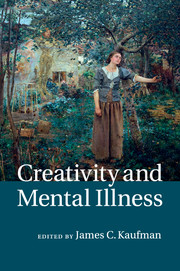Book contents
- Frontmatter
- Dedication
- Contents
- List of figures
- List of tables
- List of contributors
- Preface
- Acknowledgments
- Part I Creativity and mental illness: the state of the field
- Part II Cognitive and neuroscientific perspectives on creativity and mental illness
- Part III Creativity and the spectrum of mental illness
- Part IV Creativity and mental illness: possible commonalities
- Part V Creativity and mental health
- 15 Bringing the whole universe to order: creativity, healing, and posttraumatic growth1
- 16 Inspiration and the creative process1
- 17 King Solomon and psychoneuroimmunology: creativity and life coping
- Part VI Creativity and mental illness: what now?
- Index
- References
17 - King Solomon and psychoneuroimmunology: creativity and life coping
from Part V - Creativity and mental health
Published online by Cambridge University Press: 05 August 2014
- Frontmatter
- Dedication
- Contents
- List of figures
- List of tables
- List of contributors
- Preface
- Acknowledgments
- Part I Creativity and mental illness: the state of the field
- Part II Cognitive and neuroscientific perspectives on creativity and mental illness
- Part III Creativity and the spectrum of mental illness
- Part IV Creativity and mental illness: possible commonalities
- Part V Creativity and mental health
- 15 Bringing the whole universe to order: creativity, healing, and posttraumatic growth1
- 16 Inspiration and the creative process1
- 17 King Solomon and psychoneuroimmunology: creativity and life coping
- Part VI Creativity and mental illness: what now?
- Index
- References
Summary
What is psychoneuroimmunology?
King Solomon reigned from about 971 to 932 before the Christian era, and he is credited with writing most if not all of the biblical Old Testament book Proverbs. In Chapter 17, verse 22, we read “a cheerful heart is good medicine, but a crushed spirit dries up the bones” (New International Version). One can imagine the wise king keenly observing what was going on around him, and noting that those people who seemed to be happy and cheerful also appeared to be physically well. Conversely, those who invariably looked unhappy and miserable often also seemed to be ill. A brilliant observation, and the sort of deduction that today spawns scientific research in order to confirm the hypothesis and, if successful, to investigate the variables that may be responsible. Solomon did, however, make one assumption that, if untested, would make today’s researchers frown, that being the implied causality: “…a crushed spirit dries up the bones.” In reality, does being miserable lead to ill health, or does ill health lead a person to be miserable? Conversely, is there another factor that leads people to be both miserable and unhealthy? To confirm directionality, a controlled experiment is usually required, but then it would be a bold ethics committee that sanctioned a study designed to deliberately make people miserable to see if they then become unhealthy!
Although Solomon did not know it at the time, he was actually referring to the science of psychoneuroimmunology (PNI) – the study of the link between psychological processes such as the emotions, brain function, and the immune response that play a significant role in physical illness. Perhaps the directionality question can be resolved by looking more deeply into the mechanisms of PNI. The specific term was first used by Ader and Cohen (1975), but the origins of the modern understanding of PNI can be traced back to earlier observations on physical changes that accompany emotional states. For example, Walter Cannon (1929) found that stomach movement had ceased in experimental animals that had experienced emotional changes such as anxiety or distress.
- Type
- Chapter
- Information
- Creativity and Mental Illness , pp. 363 - 392Publisher: Cambridge University PressPrint publication year: 2014



